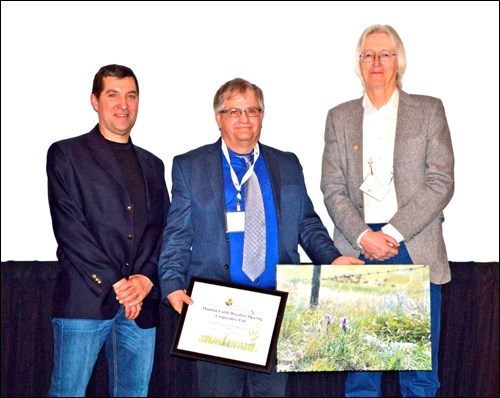Farming and ranching is more often than not a job that involves hard work, long hours, and not always a lot of recognition.
For one Saskatchewan grazing co-operative however, their diligent work and efforts in managing their native prairie grasslands were rewarded at the Native Prairie Restoration and Reclamation Workshop this past February in Regina.
The Manitou Cattle Breeders Co-op Pasture were winners of the inaugural Saskatchewan Prairie Conservation Action Plan Native Prairie Stewardship Award. The award provides recognition to a community leader or group who is having a positive impact on native prairie, wildlife, species at risk or working to raise awareness to improve overall health of range and riparian resources. The MCB is one of 13 grazing co-operatives operating on Crown lease land located within the Manitou Sand Hills near Neilburg, Senlac and Unity in west central Saskatchewan. MCB operates on more than 25,000 acres, providing grazing for approximately 720 pairs for 15 to 20 members.
The Manitou Sand Hills themselves are known to be sensitive and complex, comprised mostly of dune sand ecosites on native rangeland that is flanked by both fresh and saline water lakes. The area has been recognized by the United Nations as the Artland Sand Hills, important for its unique and diverse natural resources.
The Manitou Sand Hills have also been deemed an Important Bird Area by BirdLife International, providing valuable migratory bird habitat for many shorebirds including piping plovers, red-necked phalaropes, sanderlings and stilt sandpiper. The area is home to many rare plant species as well, including sand nutgrass, Richardson needlegrass, sand dune wheatgrass, marsh felwort and smooth monkeyflower, to name just a few.
While the sand hills are home to many beautiful and diverse species, unfortunately they are also home to one undesirable plant – leafy spurge, a noxious and invasive weed. Leafy spurge reportedly entered the area in the 1970s with industrial development and now infests approximately 15,000 to 20,000 acres in the overall area, and approximately 7,000 acres within MCB.
Spreading by both seeds and an extensive network of deep roots, leafy spurge quickly invades into prairie, taking over native grasses, forbs and shrubs, reducing biodiversity, and eventually decreasing grazing capacity.
On Crown lease land, lessees including grazing co-operatives, are responsible for controlling noxious species, which can be an expensive and time-consuming challenge for individual producers, let alone a group of 15 to 20 shareholders.
MCB has met their problem head on, however. Initially, the group received herbicide to control leafy spurge and applied it on their own time using a hand sprayer for years until their supply of herbicide eventually ran out. This didn’t deter MCB however, and they committed using their own time and resources to diligently control leafy spurge.
“We do feel responsible for trying to manage our resources well,” said Brian Nattress, a rancher and member of the MCB.
“When we ran out of herbicide and found out that we couldn’t get money for more spray, it was decided among the co-op members that we would pay out of our own pockets to supply the spray,” Nattress added.
“We are committed as a group to doing what we can to preserve what we have.”
The group marks and maps their leafy spurge patches with a GPS unit to monitor patch location and size.
“If no one does anything with spurge, it really does take over quickly. We’ve seen what happens when the spurge is left uncontrolled and unchecked,” Nattress said.
There are approximately 75 patches, including three that are large.
“We’ve divided up the workload so each member has between five and 10 patches to manage and maintain,” Nattress explained.
The MCB operates within an area that is active in oil, gas and seismic exploration. The co-operative has chosen to take any funds from industrial development and dedicate the money to continuing their leafy spurge control program. Recently, MCB was able to hire a helicopter to spray larger patches of spurge.
For Nattress and the other co-operative members who have been battling leafy spurge for decades, the Prairie Stewardship Award is meaningful.
“It’s kind of nice to have the recognition,” Nattress admitted, but added that bringing attention to invasive weed control is even more important.
“For years we’ve been trying to bring attention to the area about leafy spurge. We’ve been working with local RMs and the local weed inspector, industry and government to keep building momentum,” Nattress said. “We’re definitely moving forward,” he concluded.



